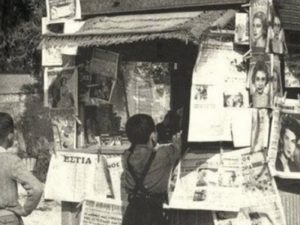 ESPRit ( European Society for Periodical Research) 8th International Conference and Doctoral Workshop
ESPRit ( European Society for Periodical Research) 8th International Conference and Doctoral Workshop
11-13 September 2019, Athens
Conference report: Emmanuelle Paccaud (emmanuelle.paccaud@unil.ch)
The ESPRit 8th International Conference and Doctoral Workshop took place at the Stavros Niarchos Foundation Cultural Center, incorporating the New Library of Greece, in Athens. The whole event provided a new insight into the state of research related to periodical studies.
Doctoral Workshop (11th September)
The workshop gave doctoral students the opportunity to present their ongoing research in fields related to the conference theme and raise questions relating mainly to methodology. They benefited from helpful feedback, as workshop moderators included leading periodical scholars, i.e. Laurel Brake, Fabio Guidali and Evanghelia Stead.
Covered fields of study were deliberately broad, in order to address topics as diverse as advertising, typography, fashion plates, literature – all approaching, from near or far, visual culture. Among the cross-cutting issues covered by the papers, mass culture and the question of representation were captured through the prism of different topics: from the popularization of short stories in periodicals to new printing techniques (e.g., graphic design and typography), including the circulation of fashion images. In terms of media material, both popular magazines and the “niche” press were represented, embracing issues related to the editorial strategies and content of periodicals. Another highlight of the workshop was the issue of digitized archives and their access, which led to discuss their use and raised related biases such as keyword research.
Both critical and cross-disciplinary perspectives were encouraged, for example by observing networks related to certain media productions in order to understand narrative media, and by “jumping outside the disciplines” – i.e. combining methods. More broadly, the workshop offered the opportunity to connect with doctoral students at a similar stage in their career as well as support and advice from later stage scholars and experts in the field.
ESPrit Conference (12-13 September)
The subject of the main conference was the visual culture of periodical literature, in its broadest sense and in a comparative context: an approach encompassing all visual aspects of periodicals, including typography, covers, format, illustration, fine and avant-garde art, cartoons, advertising copy, photojournalism, fashion, portraiture, illustrated travel accounts and ethnographic studies, religious imagery, propaganda and all other dimensions of the visual culture of the printed page.
While a broad range of media was covered (e.g., modernist magazines, literary reviews, comic strips, fashion photography, art and architecture journals, magazines dedicated to cinema or the avant-garde theatre), particular interest was expressed on the development and use of new print technologies for the reproduction of images, the juxtapositions or interactions of imagery and text, the evolution of visual tropes/memes (e.g., in propaganda and advertising), innovation in design, the emergence of new markets, studies of reader reception of and engagement with visual cultures, the formal (legal) or informal (editorial) regulation of the printed image, and the influence of periodical illustration on art and photography more broadly and on the use of imagery in the daily press in particular.
Many case studies focused on the text-to-image relationship, but also on the issue of transatlantic circulation (e.g., the negotiations between the French-Greek book publisher Tériade and his American sponsors). In this respect, the issue of the production of publications was also important. Other themes inseparable from the illustrated press were discussed, such as advertisement, often linking it with theories on the concept of modernity. Photography was also in the spotlight, for example through photographic montage. A panel organized by Italian scholars revealed fascinating analyses through film periodicals, ranging from links between cinema muto (silent films) and department stores to experimental film journals such as Bianco & Nero, to book reviews in comic forms.
At their special keynote “A little bit of what you fancy: Illustration and the Victorian press”, pioneers on periodical studies Laurel Brake and Marysa Demoor explored both the links between the Victorian illustrated press and mass consumption (e.g., through the comparison of the cover-page as a shopper-window) and the editorial strategies to reach a broader audience. The closing plenary discussed the state of periodicals studies and its future development, by reasserting the trandisciplinary perspective for periodical studies and raising perspectives that will also be discussed at next year’s ESPRit Conference which will be held in Bochum, Germany.
Emmanuelle Paccaud (emmanuelle.paccaud@unil.ch)
